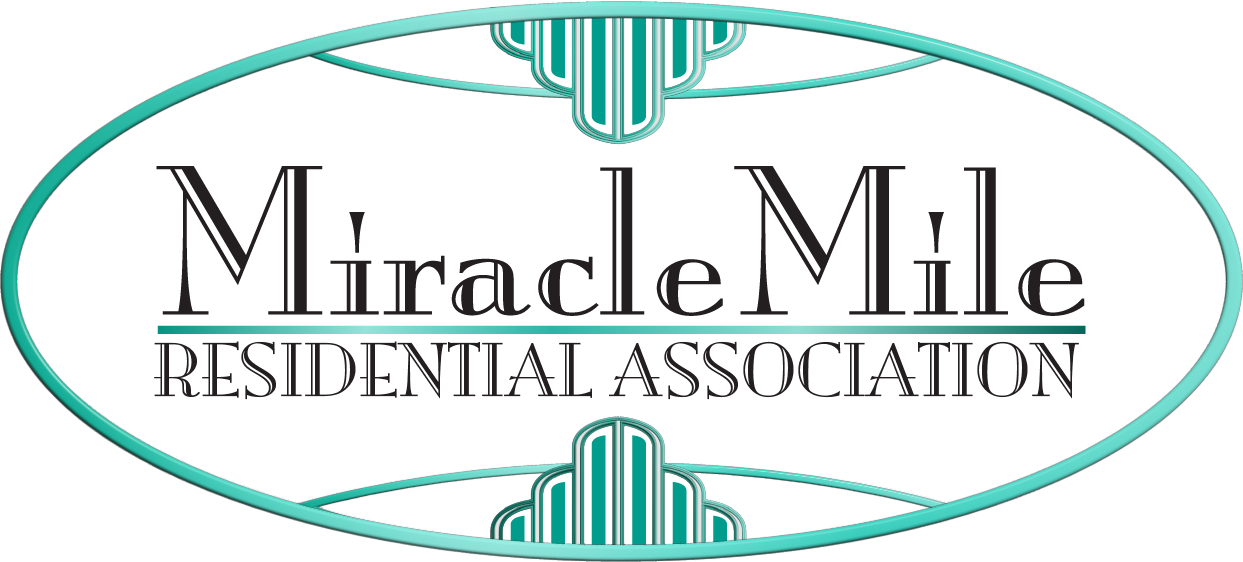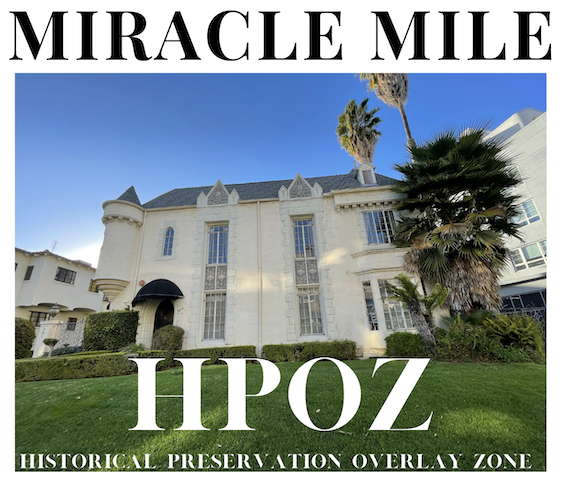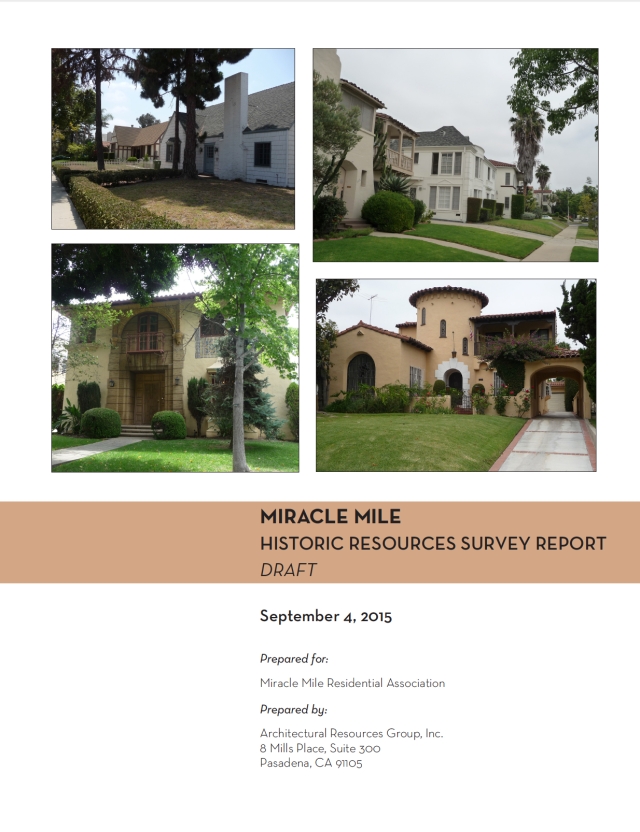The ABCs of the Miracle Mile HPOZ
The Miracle Mile Historic Preservation Overlay Zone [HPOZ] went into effect on May 1, 2017. Although the city’s Office of Historic Resources mailed official notices to every property owner within the HPOZ advising them of this zoning change there are some who are unaware of these new guidelines regarding alterations and additions to the exterior of your property. Here are some helpful points to help you navigate living in an HPOZ: Every property within the boundaries of our HPOZ [see map] – multifamily and single family homes – is guided by a Preservation Plan that will serve to protect and preserve the historic integrity and scale of our neighborhood.  Click on map to enlarge.
Click on map to enlarge.
Property owners should visit the Miracle Mile HPOZ page at www.planning.lacity.org (click on Historic Preservation and then on Local Historic Districts) to familiarize themselves with our HPOZ, the Preservation Plan, and the approvals required for exterior changes to your property.
When contemplating or planning changes to the exterior of your property first contact Erik VanBreene, the city planner in charge of administrating our HPOZ. Erik is the point person referred to as “Staff” in the Preservation Plan. He can help you understand what approvals (if any) are required. He is also a great resource for information on how to maintain and restore historic properties. The best way to contact Erik is by email at: erik.van.breen@lacity.org. He can also be contacted via telephone a 213-978-1487. The HPOZ guidelines do not apply to any building permits issued before May 1, 2017. This work is grandfathered in and no further approvals are required.
HPOZ does not regulate interior renovations or remodeling as long as these changes have no impact on the exterior appearance of your property (i.e., altering window openings or door placement).  The Miracle Mile Historic Resources Survey Reports provides a rich and detailed history of our community. A professional evaluation was made of every property within the HPOZ that determined whether it is a contributor, altered contributor, or non-contributorto our historic district. These categories determine how changes to your property may be made. There are different guidelines for contributors and non-contributors, as well as for new infill properties. The Miracle Mile HPOZ webpage has links that allow you to look up the history of your property by address and see how it was designated.
The Miracle Mile Historic Resources Survey Reports provides a rich and detailed history of our community. A professional evaluation was made of every property within the HPOZ that determined whether it is a contributor, altered contributor, or non-contributorto our historic district. These categories determine how changes to your property may be made. There are different guidelines for contributors and non-contributors, as well as for new infill properties. The Miracle Mile HPOZ webpage has links that allow you to look up the history of your property by address and see how it was designated.
Remember that the Preservation Plan provides guidelines that are meant to be flexible and still conform with the principles of historic preservation. Paint colors are exempt from HPOZ regulation as is landscaping (as long as 60% of your front yard and parkway consist of some sort of plantings and/or grass). Drought tolerant landscapes are permitted. Second-story additions and Accessory Dwelling Units are allowed to single-family homes as long as they are sensitive to the guidelines set out in the Preservation Plan.
Also, many property owners are not aware that – HPOZ or no HPOZ – city ordinances already regulate fence heights, what percentage of your front yard may be paved, what kind of trees can be planted in your parkway, and many other aspects of your property. The city also requires permits for routine work that some property owners consider DIY projects (installing new hot water heaters, replacing plumbing fixtures, window, and door change outs, etc.). Unpermitted work can negatively impact your property value, compromise your insurance coverage, and cost you additional expenses to remedy. So, when it doubt, whether it be city building permits or HPOZ guidelines: check first.
For more information on HPOZ permits and approvals visit the Frequently Asked Questions page at the Office of Historic Resources’ website. You can also visit the Information for Property Owners page.
Please share this information with your neighbors. If you are a renter make sure that your landlord or property manager is aware of the HPOZ guidelines, too. There is a learning curve to living in an HPOZ and it is important that everyone knows the ABCs of HPOZ…
For additional information visit:
at the Office of Historic Resources’ website.
Miracle Mile Historic Resources Survey Report
Maps:
Miracle Mile HPOZ Boundary Map
Miracle Mile HPOZ Findings Map
Miracle Mile HPOZ Chronology Map
Miracle Mile DPR Forms:
(by Street)
8th, 9th, 12th
Alandele
Burnside
Carmona
Cloverdale
Cochran
Curson
Detroit
Dunsmuir
Edgewood
Genesee
Hauser
Masselin
Meadowbrook
Ogden
Olympic
Orange Grove
Orange
Redondo
Ridgeley
San Vicente
Sierra Bonita
Spaulding
Stanley
Sycamore
Miracle Mile HPOZ • Frequently Asked Questions
Miracle Mile HPOZ Chairperson Mark Zecca talks with Robby O’Donnell about how an HPOZ is administered and how it impacts property owners.
The Miracle Mile Historic Preservation Overlay Zone (HPOZ) was established to protect our historic neighborhood from mansionization and overdevelopment. An HPOZ is based on a “Historic Resources Survey.” Here’s the survey team at work. (Recorded June 11, 2015)
“…historic district ordinances enable a local Historic Preservation Commission to deny inappropriate alteration or demolition of historic structures within district boundaries. They also allow for design review of new construction within the district, to help ensure that new development is compatible with the neighborhood’s unique historic character and context.”
~ Los Angeles Conservancy: Ability to Designate Historic Districts
“…as sales data bear out, homes within these historic areas sell at a premium over similar houses outside them and values outpace nearby neighborhoods…
~ Los Angeles Times: Banking on the Value of History
For additional HPOZ information:
L.A. Curbed: A Guide to Owning in a Historic Preservation Overlay Zone
Larchmont Buzz: Working on your Historic Home? Consider the Mills Act




9 thoughts on “Miracle Mile HPOZ Website”